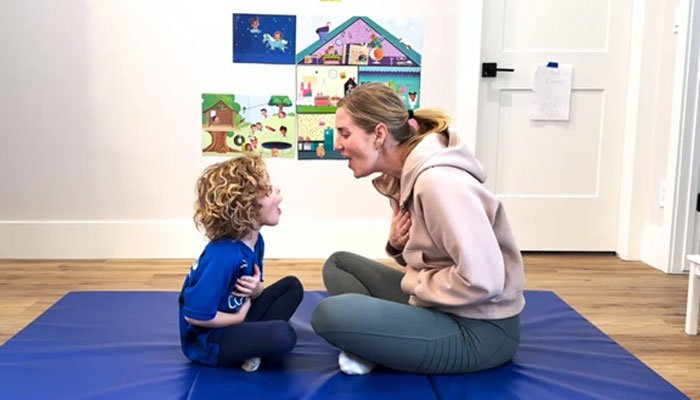- +91 7680015156
- advaithacdc@gmail.com
Deep Breathing Activities to Calm Sensory Meltdowns and Ground Emotions
- Home
- Blogs
- Deep Breathing Activities to Calm Sensory Meltdowns and Ground Emotions
Deep breathing exercises can be a valuable strategy when a child or student is overwhelmed by strong emotions. Whether the cause is sensory overload from their surroundings or heightened anxiety, practicing controlled breathing can significantly help manage their feelings.

Calming Sensory Overload and Emotional Upsets Through Deep Breathing
Children, regardless of age, experience a wide range of emotions—some days are smoother than others. However, some kids face ongoing emotional turbulence, making it challenging to help them settle once they spiral emotionally.
Children who are highly emotional might express themselves through actions such as:
- Hitting or kicking
- Prolonged crying
- Biting objects or others
- Throwing things
- Stomping or jumping repeatedly
Recognizing how a child expresses distress enables caregivers to create safe spaces and supportive outlets where the child can release and work through their emotions. Deep breathing is one of the most effective grounding tools in such moments.
Understanding Emotional Meltdowns
There are many triggers that can lead a child into a meltdown. While some can be anticipated, others may arise suddenly. To help identify potential causes, consider asking:
- Is the child hungry?
- Are they overstimulated by their environment?
- Did they encounter uncomfortable sensory input?
- Have they had adequate sleep?
- Was there any provocation or conflict?
Sometimes, the exact trigger might not be clear, but the child could react with:
- Fight or flight responses
- Panic or anxiety attacks
- Rapid breathing (hyperventilation)
- Irritability or anger
- Freezing or feeling overwhelmed
During these episodes, rational thinking diminishes as emotions take control. The child’s ability to regulate impulses and behaviors weakens, often resulting in impulsive reactions rather than composed responses. Children sensitive to sensory input may experience panic and hyperventilation more frequently.
How Deep Breathing Supports Emotional Regulation
Breath control is a quick and accessible way to help children regain calm and reengage higher-order thinking. Learning these techniques early empowers kids to self-soothe and manage overwhelming feelings independently as they grow.
According to Too Loud, Too Bright, Too Fast, Too Tight by Sharon Heller, Ph.D., regular deep breathing strengthens respiratory muscles, enhances flexibility, resets breathing patterns, and increases lung capacity — all contributing to a calmer nervous system.
Benefits of practicing deep breathing include:
- Reducing anxiety and stress
- Slowing the heart rate
- Releasing stored emotions
- Improving mental clarity and focus
- Calming the nervous system and grounding feelings
- Preventing carbon dioxide buildup by balancing inhalation and exhalation
Particularly, belly breathing helps lower heart rate and activates the body’s relaxation response, which counteracts stress and anxiety.
Guidelines for Teaching Deep Breathing
When introducing deep breathing exercises, encourage your child or student to tune into their body and emotions when calm. Teach them to ask questions like:
- “Am I feeling tired?”
- “Am I frustrated or tense?”
- “Is my body out of control?”
- “Do I need to ask for help?”
- “Am I nearing a meltdown?”
Discussing these techniques ahead of time helps children respond automatically during moments of distress. Trying to teach them mid-meltdown is less effective because emotional overwhelm impairs logical thinking.
Watch for early signs of distress and start deep breathing exercises promptly to support regulation.
Recommended Deep Breathing Exercises
Customize and try different activities to find what works best for your child’s needs and developmental level. Incorporate these into daily routines, not just during emotional crises, and adjust as necessary.
Stuffed Belly Breathing (Diaphragmatic Breathing)
Many adults breathe shallowly from the chest, but belly breathing allows for deeper, more calming breaths.
- Have your child lie down comfortably on a soft surface.
- Place a small stuffed toy on their belly.
- Ask them to breathe deeply through their nose, pushing the toy upward with their belly while keeping their chest still.
- Hold the breath for 3 seconds.
- Exhale slowly through pursed lips, feeling the toy lower.
- Repeat three times.
This method helps relax the body, reduce pain, improve posture and circulation.
Alternate Nostril Breathing (ANB)
ANB balances brain activity and regulates the nervous system.
- Close the right nostril with the thumb, exhale fully through the left nostril.
- Inhale slowly through the left nostril.
- Close the left nostril with the thumb while holding breath briefly.
- Release the right nostril and exhale slowly through it.
- Inhale through the right nostril.
- Repeat for up to 20 cycles.
Benefits include enhanced focus, mental calmness, and balanced energy.
4-7-8 Breathing Technique
- Have the child sit up straight and place their tongue behind their upper front teeth.
- Exhale completely with a whoosh sound.
- Close mouth and inhale quietly through the nose for a count of 4.
- Hold breath for 7 seconds.
- Exhale slowly with a whoosh for a count of 8.
- Repeat 4 times.
This exercise calms anxiety, supports better sleep, and improves concentration.
Blow Out the Candles
- Have the child sit comfortably and breathe deeply through their nose, expanding their belly.
- Hold breath for 3 seconds imagining smelling a birthday cake.
- Hold up five fingers as "candles" and encourage the child to blow each one out slowly.
- Repeat three times.
This activity soothes anxiety, clears the mind, and promotes calm.
Star Pose Breathing
- Child lies down comfortably on a mat.
- Knees pulled up to chest, hands resting on knees without crossing over.
- Take a deep belly breath and hold for 3 seconds.
- Exhale and stretch arms and legs out wide like a star.
- Repeat three times.
Helps reduce sensory sensitivity, lower heart rate, and encourage grounding.
Buzzing Bees Breath
- Child sits cross-legged on the floor.
- Take a deep belly breath and hold for 3 seconds.
- Exhale in short bursts through pursed lips making a buzzing sound.
- Pretend to buzz towards a flower or tree (your hand).
- Repeat three times.
This method improves focus, lowers blood pressure, relieves chest congestion, and reduces stress.
Lion’s Breath
- Child sits comfortably on the floor.
- Take a deep belly breath and hold for 3 seconds.
- Exhale loudly with a “roar” sound.
- Repeat three times.
Great for releasing facial tension, managing frustration, enhancing speech, and improving focus.
Articles
- 7 Strategies to Accomplish Positive Compliance with Retained Primitive Reflex Integration
- Child with Zinc Deficiency may show signs of Learning Challenges
- Hands-Grasping Reflex Delays Handwriting and Speech Development if Retained
- Deep Breathing Activities to Calm Sensory Meltdowns and Ground Emotions
- 3 Retained Primitive Reflexes Responsible for Poor Balance
- toe walking
- Anxious Behavior
- Retained Primitive Reflexes that Cause Sensory Sensitivities
- Retained Primitive Reflexes Causing Picky Eating, Sugar Cravings and Compulsive Eating
- Tactile Defensiveness
- 10 Fun Activities to Boost Your Child's Speech Development
- Exploring Learning through Play: Educational Activities for Kids
- Why Crossing the Midline Activities Helped this Childrens Listen to his Teacher
- Music Therapy: Study Says Music Key for Non-Verbal Children and Children with Speech and Language Delays
- Tactile Toys for Sensory Defensiveness and Tactile Stimulation

